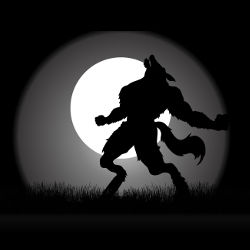LED torches - Which torch or headlamp to choose?
Drop down to find out about different torch / flashlight types! ↓ Read on for recommendations.
Start here to know which torch for your application, not why!
In this section we will try to recommend the three most popular and useful torches for each use. If your application is specialised or unusual, please contact our office on 1300 911 007 for advice on your application. We have a wide range of torches and are also able to supply custom LEDs with different wavelengths or intensities.
Police, Law Enforcement, Military
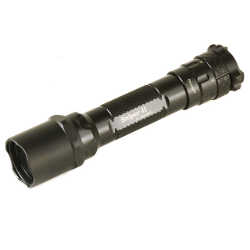 |
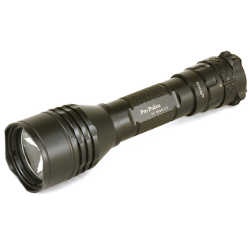 |
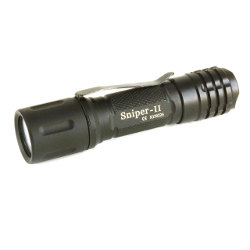 |
| 150 metres of throw and 1,620 lumens of spot surrounded by flood all in a 154mm slim 25mm body package make this torch a firm favourite of many General Duties officers. The torch chosen by the whole South Australian Police Force and many general and specialist commands throughout Australia. More info: - Sniper II Pro Ultra | The slightly larger 42mm head of the Pro Police Ultratorch give it 200 metres of throw from its 154mm body and suit those who need more distance such as rural officers. The 1,620 lumen LED with spot surrounded by flood is wider, good for searching & combined with the disorientating strobe makes it a good torch for crowd control and is favoured by units such as the NSW Public Order & Riot Squad. More Info: - Pro Police Ultra | The modest 130mm size of the Sniper II Mini flashlight makes it very confortable on an appointment belt or on the front of a weapon. It's 1,620 lumen LED output means this LED torch is well suited for room clearing and long battery life. This LED torch is a proven performer in many Defence & Police units over many years. More Info: - Sniper II MIni Ultra |
Hunting Torches
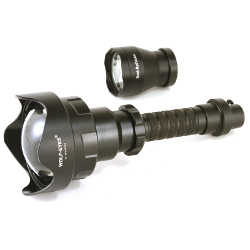 |
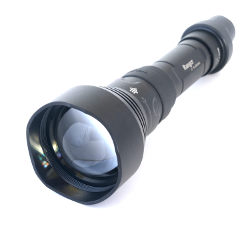 |
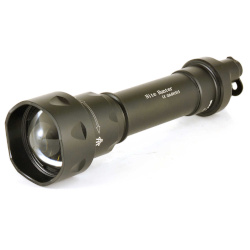 |
| The Seal is our top the line LED Hunting Torch and is supplied with two heads, the large aspheric LED head providing 600 metres of spot light and the smaller LED reflector head providing 200 metres of spot surrounded by flood light. Amazingly high output from such a relatively small hunting torch, with two heads making sure you always have the best tool for the job. More info - Seal Hunting Torch Ultra | The Ranger 56 Ultra is modest in size but throws out to 375 metres from it's LED aspheric head. This beam is all spot but can be adjusted out to a little more flood, but like all aspherics will never be spot surrounded by flood. More info - Ranger 56 Hunting Torch Ultra |
The Nitehunter Ultra is an aspheric LED hunting torch and offers 275 metres of throw, all from a very modest size. More info - NiteHunter Ultra |
General Torches
 |
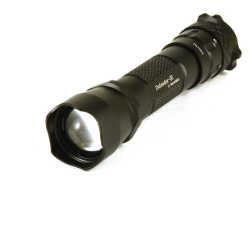 |
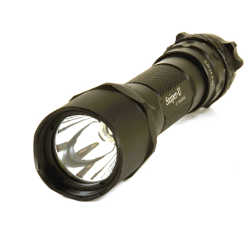 |
| The Sniper II Mini is a compact (130mm) rechargeable torch which delivers a beam consisting of spot surrounded by flood. No battery costs due to the included rechargeable battery and charger. Pocket size but tough as nails. More info - Sniper II Mini Ultra | The Defender III Pro offers the facilty of choosing the output before turning the flashlight on. This is done by the Procap on the rear and also allows easy changing once on. The Aspheric head can be adjusted from flood to spot, one handed. More info - Defender III Pro Ultra | The Wolf Eyes Sniper II Pro offers 100 metres of throw with a spot surrounded by flood beam. This is combined with the Procap which allows you to choose the level of output before or after turning on, including the strobe function. More info - Sniper II Pro Ultra |
Wildlife Photography Torches
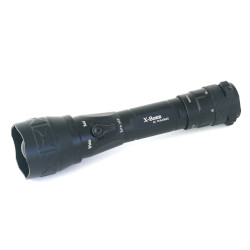 |
| The X-Beam Red is a firm favourite of wildlife photographers, wildlife tour operators and zoos all over Australia. The Red allows you to observe the animals easily without disturbing them while the white offers safety for the user. The wavelength of the Red allows long lenses to autofocus (like flash pre-flashes do) More info: - X-Beam Red Photography torch |
Night Vision compatible torches - Infra Red or IR torches
Night Vision spotting scopes or scopes generally work by three methods, either an image intensifying method such as Gen1 or Gen2 which generally give a green glow some of us are familiar with, digital night vision where a sensor uses it superior sensitivity to pick up a picture and thermal night vision which senses heat. Thermal can actually sense things you cannot see, such as an animal behind a bush, as they sense by heat. A torch or any light doesn't help thermal night vision at all, but can make a big difference to both digital and image intensifying night vision.
Infra Red wavelength torches are the best way to enhance the usefulness of your night vision device without using a conventional light - which would defeat the purpose of night vision. Infra Red (or IR) lights operate in the non visible light spectrum, so the light they emit cannot be seen. IR is a fairly wide spectrum and Wolf Eyes offer two torch wavelengths, an 850nm IR torch which while the light emitting from it is invisible, the small LED it emits from glows red. The other wavelength is 940nm which is far more stealth from the LED with a much lower signature, but at the cost of lower percieved output (Night Vision gear is less sensitive to light in the 900nm+ wavelength). Our recommendation is that unless someone may be shooting back at you, or potentially some deer or pigs can notice 850nm, we would use 850nm lights. Wolf Eyes offer four choices of IR light, the dual LED X-Beam , the NiteHunter IR , Ranger 56 IR and the Seal IR.
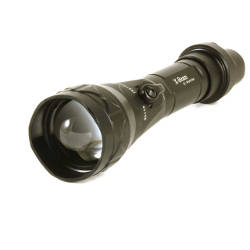 |
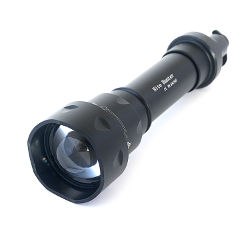 |
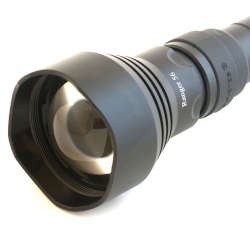 |
| The X-Beam IR is our number one choice of IR (Infra Red) torches as it has the ability to switch from IR to white light at the flick of a lever, particularly useful for locating your targets. | The NiteHunter IR is a compact torch with good throw well suited size wise to Night Vision mounting. It is IR light only so best used with another white light torch as backup. | The Ranger 56 IR is one of the longer throwing IR torches and adds substantial illumination and distance to any Night Vision scope. |
Headlamps
Wolf Eyes Rechargeable LED Headlamps all feature their full range of controls on the front, where it is instinctively easier for you to master. This allows you to control the light intensity bewteen high, medium, low, etc and also change the light beam from spot to flood - as well as turn the headlamp on and off.
All Wolf Eyes Rechageable LED Headlamps use the same LRB168A or LRB168P lithium ion rechargeable batterries as our rechargeable LED torches. Because the battery is so energy dense only only one is required. This is placed at the back of the head to balance the light controls on the front, because it is so light you don't get the slap on the head when moving quickly or running as you do with the larger battery pack style of headlamps.
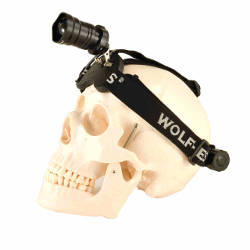 |
 |
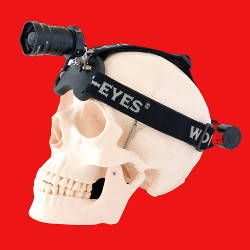 |
| The Lunar is a great choice for those running through the bush, trails or even on the pavement. The all in one headlamp design is lighter but still provides easy adjustment from spot to flood. | The Dingo is supplied with two lenses, one lens for long distance and one for medium distance. One great feature of the Dingo is the ability to be used with no lens, providing an even flouro like light out to about 5 metres, great for machinery repairs or tying fishing lines. |
The Lunar RED is the same Lunar but with a RED only LED for use near animals so as not to spook them of for those who don't want to affect their night vision. We also supply the Dingo RED as well. |
These are just some of a large variety of torches and headlamps, night vision scopes and thermal scopes. Many ask for the brightest torch, longest beam torch, furthest throwing torch, brightest LED Torch, most powerful LED torch but in most cases it is best to match the torch or flashlight to the application. We are also able to offer custom engraving for sufficient quantities, such as a Police unit. This custom engraving is on the flat side of your LED torch, where the torch model designation would normally be. If you need any advice on general applications or specialist applications, such as different nanometers of light, just call or email and we will be only to happy to help. Call on 1300 911 007 and we will answer the phone here in Australia
Which torch to choose? Choosing the right tool is important for any job. The fact that you are reading this means you are probably looking for a modestly sized high powered LED torch. You may well work in law enforcement, be a hunter, wildlife photographer, wildlife tour operator or an industry professional who needs a quality torch. You probably use Wolf Eyes Torches departmentally at work, this research may even be for your department. Or you might just be someone who likes quality equipment and high performance.
Light Source: When torches were first invented the light source was incandescent, or the standard globe as we know it. These days the choice has widened with both LEDs and HID torches available. Each has their advantages.
Incandescent globes produce full spectrum light, meaning it has all wavelengths or all colours of the rainbow. This means you can put a filter over the light and get the filtered wavelength light projecting out the front (filters work by restraining unwanted wavelengths and only letting the desired wavelength through - ie red filters only let the red wavelength through). The disadvantage of incandescent globe torches is high power use, because the globe is producing all these wavelengths (including unseen ones such as IR - infra red) and heat the power use is high and batteries flatten quicker. Incandescent globes also produce high heat. Incandescent globes in torches often blow quicker, this is because to make the filament glow brighter you have to make it thinner, which makes it less durable. This is especially true when the torch globe is turned on or immediately after turning off. These days it is hard to find incandescent torches but we can provide some of our models in incandescent versions if required.
HID (or high intensity discharge) torches produce big outputs. Primarily used for searchlight style lights these days, they were the first huge output light sources for torches (unusual fact - Wolf Eyes used to produce the smallest HID torch in the world, the Wolf Eyes Boxer). Generally the HID element is housed in a large reflector relative to the element due to the high heat output, these larger reflectors usually provide good throw. HID is a form of arc lighting and generally consists of two electrodes in a capsule filled with gas and mineral salts. The gas helps the arc strike which then excites the mineral salts which jump around till they evaporate and produce plasma which intensifies the light. This also explains the delay when an HID light is turned on till you get full power. The advantages of HID are high output, full spectrum light and durability, the disadvantages are the torch takes time to get up to full intensity, especially with the small ballasts in torches, often 30 or so seconds and also very high heat. As LEDs have similar characteristics now in the smaller HID outputs, they have replaced them at that level of torch or flashlight and HID is usually only found in higher output searchlight style torches.
LEDs. LEDs or Light Emitting Diodes to give them their full name are the primary light source for most torches produced today. The advantages of LEDs are numerous, they are durable and shock resistant, they are now available in high outputs and consume low amounts of power for the light produced - and becoming more efficient daily (the reason watts are not a good indication of output). They also produce low heat output at low light outputs. The disadvantages of LEDs are high heat output at high light outputs (one of the reasons we have our TTT - Thermal Transfer Tube) and potentially their narrow spectrum light output. This means filters are not very effective on LEDs as often there isn't much of the secondary wavelength to filter through, For example, a white LED doesn't have much red in it so when a red filter is placed over it the output is substantially reduced. This narrow spectrum output can also be seen as an advantage, as specific wavelength LEDs can be tailored for special purpose torches. An example would be Infra Red (IR) LEDs being made for torches used with night vision equipment or something like 470Nm Blue used for tracking blood or biological matter. In many ways LED is the most practical light source for a torch and the most likely you will choose due to it being the dominant offering in torches.
LEDs work by being part of an electrical circuit, they are a diode which emits light when connected to a circuit in the correct polarity. The LED has semi conductor chip in the centre, this chip has two regions seperated by a junction. The P region is predominantly positive electrical charges and the N region is predominantly negative electrical charges. When a large enough voltage is applied to the LED electrons can easily move across the junction and to the positive forces of the P region. When the electron moves close enough to a positive charge in the P region they recombine. At this point some electrical potential energy is converted into electromagnetic energy, some of this is released as a photon of light. This photon has a frequency determined by the characteristics LED material (usually a combination of phosphorous, arsenic and gallium). To achieve different wavelengths we use different materials. Probably more information than you ever wanted to know about LEDs!
Power Source: Without a doubt lithium ion is the premium power source for a torch or flashlight. They are very energy dense batteries and will even work in sub zero conditions - we have quite a few pictures of Wolf Eyes LED Torches working after being frozen inside blocks of ice! The advantages of Lithium Ion batteries are huge energy density, meaning usually only one battery is required allowing a small form factor (most Wolf Eyes Torches have a 25.4mm body, perfect hand size due to this), the ability to function well in very cold conditions and great rechargeability for low running costs. This is probably the reason cars like the Tesla are totally powered by the exact same battery as in your torch - though they have a few more of them - 8,000 to be exact! The disadvantages are they are expensive in disposable form or require a charger in rechargeable form and also they require a protection circuit to be totally safe. The alternative power sources are AA, C, D cells or the NiMH rechargeable versions. The advantages of those are easy common availability. The disadvantages are low power output, usually requiring multiple batteries and poor performance in cold conditions. We have a couple of AA battery torches at Wolf Eyes, but as our torches are predominantly high output LED torches (running V8 levels of LEDs output up front) we need the best power source.
An interesting fact is that the name flashlight came about because of the poor batteries of the very first torches or flashlights. They were only able to power the torches for a few seconds at a time, providing just a 'flash of light', so becoming known as flashlights.
Regulation
Regulation is where the brightness is kept consistent and doesn't dim as the battery flattens. All batteries reduce in voltage as they flatten, which usually means your light also dims (often at a slow rate with LEDs compared to incandescent so not easily noticed until you compare a light with fresh batteries). To counter the problem of your torch dimming, every Wolf Eyes torch has an electronic regulation unit added which increases the amperage as the voltage lowers, ensuring your torch has optimum power required.
Regulation also solves two other linked problems. If too much power is applied to an LED it can overheat, it will provide brighter light for a short period, it will then have reduced light output for the rest of the LED's life. LEDs suffer from an issue known as LED Droop. LEDs become brighter as more power is applied, then at a certain point that changes and the brightness gain is extremely incremental even after large current increases. One objective of regulation is to keep the LED in the area of it's maximum operating efficiency, not suffering LED Droop or overheating. PS If you solve LED Droop you will be solving one of the big problems of the 21st century!
Battery Charger: The battery charger is also very important. Whilst this isn't a comparison of different chargers for your LED rechargeable torch, we do have one important recommendation - always use an Austalian Approved charger. Whilst the approval is no guarantee of how well it will work as a charger, it is a guarantee that it is safe and legal to plug into the Australian Electricity Network. Poor quality chargers can and do catch fire, as has been observed with phones, notebooks and more recently hoverboards & electric bikes. For the sake of a few dollars it isn't worth the risk of voiding your insurance and putting your workmates or family at risk. All Wolf Eyes Chargers are Australian Approved.
Beam Type: There are two main beam types and this is probably the first and biggest decision to make when choosing your new torch. There is the Reflector Beam, which uses a conventional highly polished reflector to provide a beam which is spot surrounded by flood. There is also the Aspheric Beam, which uses an aspheric lens (like a magnifying glass) on the front to concentrate the beam, this is also adjustable to provide flood.
The Reflector Beam is produced by a highly polished reflector surrounding the light source, usually an LED (little known fact, Wolf Eyes torches change the reflector slightly to suit each new version of LED, they all have slightly different beam characteristics). This is a great beam for searching as the surrounding flood supplies light outside the point of aim of the torch. This is probably the best style of beam for most police or military applications, such as clearing a room or searching for an offender as the extra flood light around the spot allows you to see more, for example other corners of a room and the gradual change from the brightness of the spot encourages your eyes to look outside the spot. Being fixed it requires no input from the operator to adjust, so great for those operating in high stress situations and will always be adjusted correctly no matter how hectic the action surrounding it. Of course this is also a great beam style to find your dog!
The Aspheric Beam is produced by an aspheric lens (like a magnifying glass) placed in front of the LED. This concentrates the light of the torch but can also be adjusted to provide flood, by varying the distance of the lens from the LED. The Aspheric Beam is a tremendous style of beam for situations where a spot is required such as on a scope or for say wildlife photography. When in spot mode an aspheric beam produces all spot with no flood at all, with all light from the LED going into the spot. This provides a beam which reaches farther than an a reflector beam of the same power. This is the strength of a aspheric torch and the bright spot concentrates ones eyes on it. The aspheric lens can also be adjusted to provide all flood. The LED and aspheric lens can be adjusted to halfway points between spot or flood, but an aspheric lens can never really provide spot surrounded by flood, as the design intention of the aspheric is to concentrate the light of the LED.
In summary it would be best to choose an Aspheric Beam for applications where distance is paramount, such as scope use at distance and these torch beams usually shine from 200 to 600 metres. In applications where all around visibility is more important such as searching or for room clearing, then an a Reflector Beam would be recommended, in a torch these beams normally shine 100 to 200 metres.
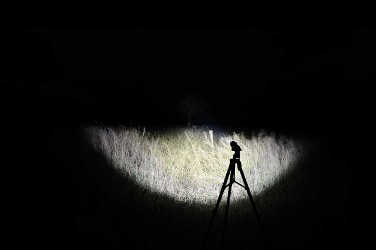 |
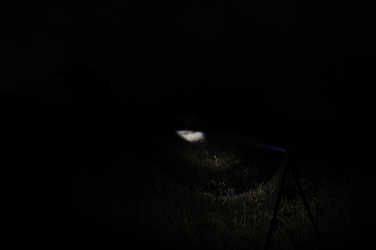 |
| Reflector Beam | Aspheric Beam |




